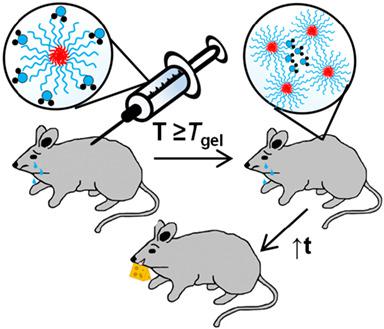当前位置:
X-MOL 学术
›
Polym. Int.
›
论文详情
Our official English website, www.x-mol.net, welcomes your
feedback! (Note: you will need to create a separate account there.)
Pre-clinical and clinical applications of thermoreversible hydrogels in biomedical engineering: a review
Polymer International ( IF 2.9 ) Pub Date : 2021-06-05 , DOI: 10.1002/pi.6266 Anna P. Constantinou 1 , Theoni K. Georgiou 1
Polymer International ( IF 2.9 ) Pub Date : 2021-06-05 , DOI: 10.1002/pi.6266 Anna P. Constantinou 1 , Theoni K. Georgiou 1
Affiliation

|
Thermoreversible polymer hydrogels (TRGs) are physical aqueous networks triggered by temperature that find potential applications in tissue engineering (TE) and drug/gene delivery. When systems with lower critical solution temperature (LCST) behaviour are used, the aqueous solution of polymer is mixed with cells or drugs/genes, depending on the desired application, at room temperature and then injected in vivo to form a hydrogel. This in situ forming hydrogel acts as a matrix for tissue regeneration or controlled and targeted release of the compound. This review focuses on discussing the studies in which synthetic TRGs with LCST behaviour have been applied in vivo in model animals. These studies are categorised depending on the general structure of the polymer, as follows: (i) poloxamers (also known as Pluronics®), (ii) degradable polymers, (iii) poly(N-isopropylacrylamide), (iv) poly(organophosphazene) and (v) poly(2-ethyl-2-oxazoline). In general, when the system is optimised, TRGs provide sustained and topical release of the drugs, thus minimising the undesired side effects. When applied in the TE field, tissue formation was observed. Interestingly, two polymers have reached clinical trials, namely poloxamer 407 (P407, Pluronic® F127, often combined with P188, F68) and Regel® (the formulation of Regel® with the anticancer agent paclitaxel is known as Oncogel®), indicating the challenges that need to be overcome before successful application in clinics. © 2021 The Authors. Polymer International published by John Wiley & Sons Ltd on behalf of Society of Industrial Chemistry.
中文翻译:

热可逆水凝胶在生物医学工程中的临床前和临床应用:综述
热可逆聚合物水凝胶 (TRG) 是由温度触发的物理水性网络,在组织工程 (TE) 和药物/基因传递中具有潜在应用。当使用具有较低临界溶解温度 (LCST) 行为的系统时,聚合物的水溶液与细胞或药物/基因混合,具体取决于所需的应用,在室温下,然后在体内注射以形成水凝胶。这种原位形成的水凝胶充当组织再生或化合物受控和靶向释放的基质。本综述重点讨论具有 LCST 行为的合成 TRG 已在体内应用的研究在模型动物中。这些研究根据聚合物的一般结构分类如下:(i)泊洛沙姆(也称为 Pluronics®),(ii)可降解聚合物,(iii)聚(N-异丙基丙烯酰胺),(iv)聚(有机磷腈)和(v)聚(2-乙基-2-恶唑啉)。一般来说,当系统被优化时,TRGs 提供药物的持续和局部释放,从而最大限度地减少不需要的副作用。当应用于 TE 场时,观察到组织形成。有趣的是,两种聚合物已进入临床试验阶段,即泊洛沙姆 407(P407、Pluronic® F127,通常与 P188、F68 结合使用)和 Regel®(Regel® 与抗癌剂紫杉醇的制剂称为 Oncogel®),表明了挑战在临床成功应用之前需要克服这些问题。© 2021 作者。由 John Wiley & Sons Ltd 代表工业化学学会出版的Polymer International。
更新日期:2021-06-05
中文翻译:

热可逆水凝胶在生物医学工程中的临床前和临床应用:综述
热可逆聚合物水凝胶 (TRG) 是由温度触发的物理水性网络,在组织工程 (TE) 和药物/基因传递中具有潜在应用。当使用具有较低临界溶解温度 (LCST) 行为的系统时,聚合物的水溶液与细胞或药物/基因混合,具体取决于所需的应用,在室温下,然后在体内注射以形成水凝胶。这种原位形成的水凝胶充当组织再生或化合物受控和靶向释放的基质。本综述重点讨论具有 LCST 行为的合成 TRG 已在体内应用的研究在模型动物中。这些研究根据聚合物的一般结构分类如下:(i)泊洛沙姆(也称为 Pluronics®),(ii)可降解聚合物,(iii)聚(N-异丙基丙烯酰胺),(iv)聚(有机磷腈)和(v)聚(2-乙基-2-恶唑啉)。一般来说,当系统被优化时,TRGs 提供药物的持续和局部释放,从而最大限度地减少不需要的副作用。当应用于 TE 场时,观察到组织形成。有趣的是,两种聚合物已进入临床试验阶段,即泊洛沙姆 407(P407、Pluronic® F127,通常与 P188、F68 结合使用)和 Regel®(Regel® 与抗癌剂紫杉醇的制剂称为 Oncogel®),表明了挑战在临床成功应用之前需要克服这些问题。© 2021 作者。由 John Wiley & Sons Ltd 代表工业化学学会出版的Polymer International。











































 京公网安备 11010802027423号
京公网安备 11010802027423号